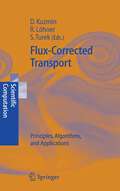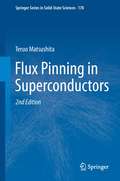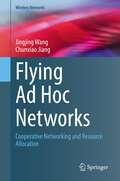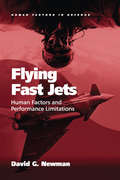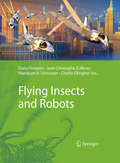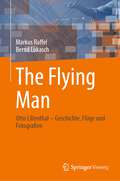- Table View
- List View
Fluvial Hydraulics
by S. Lawrence DingmanFluvial Hydraulics provides a sound qualitative and quantitative understanding of water and sediment flows in natural rivers. This understanding is essential for modeling and predicting hydrologic and geomorphologic processes, erosion, sediment transport, water supply and quality, habitat management, and flood hazards. This book's coverage bridges the gap between the highly quantitative mechanics-based civil-engineering approach to stream hydraulics and the more qualitative treatments of fluvial geomorphology typical of earth-sciences and natural-resources curricula. Measurements of natural river flows illustrate many central concepts. The book is specifically designed for upper-level students and practitioners who are interested in a fundamental understanding of river behavior. An introduction to the history of fluvial hydraulics and an overview of the morphology and hydrology of rivers provides the context for the rest of the text. A thorough understanding of water properties, including turbulence, is developed via a series of simple thought experiments. The bases of the equations that are used to describe and predict river flows are systematically presented, including dimensional analysis. Subsequent chapters build logically on these foundations, covering velocity distributions, new insights to the central topic of flow resistance, the magnitudes of forces in natural river flows, the principles of conservation of energy and momentum, the prediction of water-surface profiles, the principles of flow measurement, mechanics, and geomorphic aspects of sediment transport. The book will be especially valuable in providing a scientific basis for the growing field of river restoration. An appendix reviews dimenstions, units, and numerical precision. Over 250 references are cited, providing an entree to the extensive multi-disciplinary literature on rivers. The book's website provides suggestions for student exercises and makes available extensive data bases of measured streamflows for student exploration.
Fluvial Hydrodynamics: Hydrodynamic and Sediment Transport Phenomena (GeoPlanet: Earth and Planetary Sciences)
by Subhasish DeyThe state-of-the-art in fluvial hydrodynamics can be examined only through a careful exploration of the theoretical development and applied engineering technology. The book is primarily focused, since most up-to-date research findings in the field are presented, on the research aspects that involve a comprehensive knowledge of sediment dynamics in turbulent flows. It begins with the fundamentals of hydrodynamics and particle motion followed by turbulence characteristics related to sediment motion. Then, the sediment dynamics is analysed from a classical perspective by applying the mean bed shear approach and additionally incorporating a statistical description for the role of turbulence. The work finally examines the local scour problems at hydraulic structures and scale models. It is intended to design as a course textbook in graduate / research level and a guide for the field engineers as well, keeping up with modern technological developments. Therefore, as a simple prerequisite, the background of the readers should have a basic knowledge in hydraulics in undergraduate level and an understanding of fundamentals of calculus.
Fluvial Hydrodynamics: Hydrodynamic and Sediment Transport Phenomena (GeoPlanet: Earth and Planetary Sciences)
by Subhasish DeyThis revised second edition of the book presents an improvement of the original version in terms of recent research, corrections, and outline. The state of the art in fluvial hydrodynamics can be examined only through a careful exploration of the theoretical development and applied engineering technology. This second, updated edition focuses, since most up-to-date research findings in the field are presented, on the research aspects that involve a comprehensive knowledge of sediment dynamics in turbulent flows. It begins with the fundamentals of hydrodynamics and particle motion followed by turbulence characteristics related to sediment motion. Sediment dynamics are described from a classical perspective by applying the mean bed shear approach and additionally incorporating a statistical description for the role of turbulence. It is intended to design as a course textbook in graduate / research level and a guide for the field engineers as well, keeping up with modern technological developments. One of the most important additions is that at the end of each chapter, varieties of problems were given. Therefore, as a simple prerequisite, the background of the readers should have a basic knowledge in hydraulics in undergraduate level and an understanding of fundamentals of calculus.
Fluvial Hydrosystems
by C. Amoros G. E. PettsFluvial Hydrosystems provides a unified approach to the study of running waters and aims to provide a scientific basis for sustainable management of rivers. It differs from traditional texts in viewing rivers as structured, four-dimensional systems and integrating ecological and geomorphological approaches to provide a holistic perspective on river dynamics. Advanced students of geomorphology, ecology, environmental science, land use and civil engineering will all benefit from this wide-ranging and stimulating textbook.
Fluvial Processes: 2nd Edition (IAHR Monographs)
by Ana Maria da Silva M. Selim YalinA stream flowing in alluvium deforms its bed surface, forming ripples, dunes, bars, etc., and, in many instances, it deforms its channel entirely, thereby creating meandering or braiding patterns. It could be said that, in general, an alluvial stream and its deformable boundary undergo a variety of fluvial processes leading to the emergence of a multitude of alluvial forms. This book concerns the physics and analytical treatment of various fluvial processes and the associated alluvial bed and plan forms listed above. Following an introductory chapter on the basics of turbulent flow and sediment transport, the book covers the origin, geometric characteristics and effects of bed forms, from small- to meso-scale (ripples, dunes, alternate and multiple bars); the initiation, geometry and mechanics of meandering streams; the computation of flow, bed deformation and the planimetric evolution of meandering streams; and braiding and delta formation. The book also covers the regime concept, the time-development of a stream towards its regime state, and the formulation of stable, or equilibrium, morphology. The book distinguishes itself by its comprehensive analysis and discussion of key processes involved in large-scale river morphodynamics. The book was written primarily for researchers and graduate students of hydraulic engineering, water resources and related branches of earth sciences, but it will also prove useful for river engineers and managers.
Fluvial Processes: 2nd Edition (IAHR Monographs)
by Ana Maria da Silva M. Selim YalinA stream flowing in alluvium deforms its bed surface, forming ripples, dunes, bars, etc., and, in many instances, it deforms its channel entirely, thereby creating meandering or braiding patterns. It could be said that, in general, an alluvial stream and its deformable boundary undergo a variety of fluvial processes leading to the emergence of a multitude of alluvial forms. This book concerns the physics and analytical treatment of various fluvial processes and the associated alluvial bed and plan forms listed above. Following an introductory chapter on the basics of turbulent flow and sediment transport, the book covers the origin, geometric characteristics and effects of bed forms, from small- to meso-scale (ripples, dunes, alternate and multiple bars); the initiation, geometry and mechanics of meandering streams; the computation of flow, bed deformation and the planimetric evolution of meandering streams; and braiding and delta formation. The book also covers the regime concept, the time-development of a stream towards its regime state, and the formulation of stable, or equilibrium, morphology. The book distinguishes itself by its comprehensive analysis and discussion of key processes involved in large-scale river morphodynamics. The book was written primarily for researchers and graduate students of hydraulic engineering, water resources and related branches of earth sciences, but it will also prove useful for river engineers and managers.
Fluvial Remote Sensing for Science and Management (Advancing River Restoration and Management)
by Patrice E. Carbonneau Hervé PiégayThis book offers a comprehensive overview of progress in the general area of fluvial remote sensing with a specific focus on its potential contribution to river management. The book highlights a range of challenging issues by considering a range of spatial and temporal scales with perspectives from a variety of disciplines. The book starts with an overview of the technical progress leading to new management applications for a range of field contexts and spatial scales. Topics include colour imagery, multi-spectral and hyper-spectral imagery, video, photogrammetry and LiDAR. The book then discusses management applications such as targeted, network scale, planning, land-use change modelling at catchment scales, characterisation of channel reaches (riparian vegetation, geomorphic features) in both spatial and temporal dimensions, fish habitat assessment, flow measurement, monitoring river restoration and maintenance and, the appraisal of human perceptions of riverscapes. Key Features: • A specific focus on management applications in a period of increasing demands on managers to characterize river features and their evolution at different spatial scales • An integration across all scales of imagery with a clear discussion of both ground based and airborne images • Includes a wide-range of environmental problems • Coverage of cutting-edge technology • Contributions from leading researchers in the field
Fluvial Remote Sensing for Science and Management (Advancing River Restoration and Management)
by Patrice Carbonneau Hervé Piégay Herv Pi GayThis book offers a comprehensive overview of progress in the general area of fluvial remote sensing with a specific focus on its potential contribution to river management. The book highlights a range of challenging issues by considering a range of spatial and temporal scales with perspectives from a variety of disciplines. The book starts with an overview of the technical progress leading to new management applications for a range of field contexts and spatial scales. Topics include colour imagery, multi-spectral and hyper-spectral imagery, video, photogrammetry and LiDAR. The book then discusses management applications such as targeted, network scale, planning, land-use change modelling at catchment scales, characterisation of channel reaches (riparian vegetation, geomorphic features) in both spatial and temporal dimensions, fish habitat assessment, flow measurement, monitoring river restoration and maintenance and, the appraisal of human perceptions of riverscapes. Key Features: • A specific focus on management applications in a period of increasing demands on managers to characterize river features and their evolution at different spatial scales • An integration across all scales of imagery with a clear discussion of both ground based and airborne images • Includes a wide-range of environmental problems • Coverage of cutting-edge technology • Contributions from leading researchers in the field
Flux Bounded Tungsten Inert Gas Welding Process: An Introduction
by P Chakravarthy M Agilan N NeethuThis focus book is intended to introduce the Flux Bounded Tungsten Inert Gas Welding (FBTIG) process, which is a variant of Activated Tungsten inert gas welding process. The benefits of activating flux in the weld pool in enhancing the depth of penetration and underlying mechanisms for the same is explained in detail. The benefits of FBTIG process over other fusion welding process are highlighted. The scope for the FBTIG process to be adapted at the industrial level and the advancements in this field is detailed that enables the practicing engineers to exploit the same. Covers activated TIG process, role of activating fluxes in enhancing the depth of penetration Illustrates mechanisms associated with FBTIG process including arc constriction effect, insulation effect and reverse marangoni flow Discusses scope of FBTIG process for commercialization at the industry level Gives general overview of chronological advancements in the field of welding This book is aimed at graduate students, researchers and professionals in welding, manufacturing and engineering.
Flux Bounded Tungsten Inert Gas Welding Process: An Introduction
by P Chakravarthy M Agilan N NeethuThis focus book is intended to introduce the Flux Bounded Tungsten Inert Gas Welding (FBTIG) process, which is a variant of Activated Tungsten inert gas welding process. The benefits of activating flux in the weld pool in enhancing the depth of penetration and underlying mechanisms for the same is explained in detail. The benefits of FBTIG process over other fusion welding process are highlighted. The scope for the FBTIG process to be adapted at the industrial level and the advancements in this field is detailed that enables the practicing engineers to exploit the same. Covers activated TIG process, role of activating fluxes in enhancing the depth of penetration Illustrates mechanisms associated with FBTIG process including arc constriction effect, insulation effect and reverse marangoni flow Discusses scope of FBTIG process for commercialization at the industry level Gives general overview of chronological advancements in the field of welding This book is aimed at graduate students, researchers and professionals in welding, manufacturing and engineering.
Flux-Corrected Transport: Principles, Algorithms, and Applications (Scientific Computation)
by Dmitri Kuzmin, Rainald Löhner and Stefan TurekAddressing students and researchers as well as Computational Fluid Dynamics practitioners, this book is the most comprehensive review of high-resolution schemes based on the principle of Flux-Corrected Transport (FCT). The foreword by J.P. Boris and historical note by D.L. Book describe the development of the classical FCT methodology for convection-dominated transport problems, while the design philosophy behind modern FCT schemes is explained by S.T. Zalesak. The subsequent chapters present various improvements and generalizations proposed over the past three decades. In this new edition, recent results are integrated into existing chapters in order to describe significant advances since the publication of the first edition. Also, 3 new chapters were added in order to cover the following topics: algebraic flux correction for finite elements, iterative and linearized FCT schemes, TVD-like flux limiters, acceleration of explicit and implicit solvers, mesh adaptation, failsafe limiting for systems of conservation laws, flux-corrected interpolation (remapping), positivity preservation in RANS turbulence models, and the use of FCT as an implicit subgrid scale model for large eddy simulations.
Flux-Corrected Transport: Principles, Algorithms, and Applications (Scientific Computation)
by Dmitri Kuzmin Rainald Löhner Stefan TurekAddressing students and researchers as well as CFD practitioners, this book describes the state of the art in the development of high-resolution schemes based on the Flux-Corrected Transport (FCT) paradigm. Intended for readers who have a solid background in computational fluid dynamics, the book begins with historical notes by J.P. Boris and D.L. Book. Review articles that follow describe recent advances in the design of FCT algorithms as well as various algorithmic aspects. The topics addressed in the book and its main highlights include: the derivation and analysis of classical FCT schemes, with special emphasis on the underlying physical and mathematical constraints; flux limiting for hyperbolic systems; generalization of FCT to implicit time-stepping and finite element discretizations on unstructured meshes and its role as a subgrid scale model for Monotonically Integrated Large Eddy Simulation (MILES) of turbulent flows. The proposed enhancements of the FCT methodology also comprise the prelimiting and 'failsafe' adjustment of antidiffusive fluxes, the use of characteristic variables, and iterative flux correction. The cause and cure of detrimental clipping/terracing effects are discussed. Many numerical examples are presented for academic test problems and large-scale applications alike.
Flux Pinning in Superconductors (Springer Series in Solid-State Sciences #178)
by Teruo MatsushitaThe book covers the flux pinning mechanisms and properties and the electromagnetic phenomena caused by the flux pinning common for metallic, high-Tc and MgB2 superconductors. The condensation energy interaction known for normal precipitates or grain boundaries and the kinetic energy interaction proposed for artificial Nb pins in Nb-Ti, etc. are introduced for the pinning mechanism. Summation theories to derive the critical current density are discussed in detail. Irreversible magnetization and AC loss caused by the flux pinning are also discussed. The loss originally stems from the ohmic dissipation of normal electrons in the normal core driven by the electric field induced by the flux motion.The readers will learn why the resultant loss is of hysteresis type in spite of such mechanism. The influence of the flux pinning on the vortex phase diagram in high Tc superconductors is discussed and the dependencies of the irreversibility field are also described on other quantities such as anisotropy of superconductor, specimen size and electric field strength. Recent developments of critical current properties in various high-Tc superconductors and MgB2 are introduced.Other topics are: singularity in the case of transport current in a parallel magnetic field such as deviation from the Josephson relation, reversible flux motion inside pinning potentials which causes deviation from the critical state model prediction, the concept of the minimization of energy dissipation in the flux pinning phenomena which gives the basis for the critical state model, etc. Significant reduction in the AC loss in AC wires with very fine filaments originates from the reversible flux motion which is dominant in the two-dimensional pinning. The concept of minimum energy dissipation explains also the behavior of flux bundle size which determines the irreversibility line under the flux creep.The new edition has been thoroughly updated, with new sections on the progress in enhancing the critical current density in high temperature superconductors by introduction of artificial pinning centers, the effect of packing density on the critical current density and irreversibility field in MgB2 and derivation of the force-balance equation from the minimization of the free energy including the pinning energy.
Flux Pinning in Superconductors
by Teruo MatsushitaThe book deals with the flux pinning mechanisms and properties and the electromagnetic phenomena caused by the flux pinning common for metallic, high-temperature and MgB2 superconductors. The loss originates from the ohmic dissipation of normal electrons in the normal core driven by the electric field induced by the flux motion. Readers will learn why the resultant loss is of hysteresis type in spite of such mechanism.
Flux Pinning in Superconductors (Springer Series in Solid-State Sciences #198)
by Teruo MatsushitaThis book covers the flux pinning mechanisms and properties and the electromagnetic phenomena caused by the flux pinning common for metallic, high-Tc and MgB2 superconductors. The condensation energy interaction known for normal precipitates or grain boundaries and the kinetic energy interaction proposed for artificial Nb pins in Nb-Ti, etc., are introduced for the pinning mechanism. Summation theories to derive the critical current density are discussed in detail. Irreversible magnetization and AC loss caused by the flux pinning are also discussed. The loss originally stems from the ohmic dissipation of normal electrons in the normal core driven by the electric field induced by the flux motion.The influence of the flux pinning on the vortex phase diagram in high Tc superconductors is discussed, and the dependencies of the irreversibility field are also described on other quantities such as anisotropy of superconductor, specimen size and electric field strength. Recent developments of critical current properties in various high-Tc superconductors and MgB2 are introduced.The 3rd edition has been thoroughly updated, with a new chapter on critical state model. The mechanism of irreversible properties is discussed in detail. The author provides calculations of pinning loss by the equation of motion of flux lines in the pinning potential and hysteresis loss. The readers will learn why the resultant loss is of hysteresis type in spite of such mechanism. This book aims for graduate students and researchers studying superconductivity as well as engineers working in electric utility industry.
Fluxes of Carbon, Water and Energy of European Forests (Ecological Studies #163)
by Riccardo ValentiniAfter years of technological development and its important achievements to make our life easier and more comfortable, human society is going to face one of the most difficult challenges of the last century: to stabilize the concentra tion levels of greenhouse gases in the atmosphere to prevent harmful effects on the climate system. Through a delicate balance between photosynthesis and respiration, terres trial ecosystems, and in particular forests, are today thought to take up a sig nificant part of the carbon dioxide emissions in the atmosphere, sometimes called the "terrestrial carbon sink". However, the location, magnitude, and vulnerability of the carbon dioxide sink of the terrestrial biota are still uncer tain. The suite of traditional tools in an ecologist's toolbox for studying ecosys tem productivity and carbon balance include leaf cuvettes, whole-plant and soil chambers for gas exchange, and biomass and soil carbon inventories. While each of the cited methods has distinct advantages, they are limited with regards to their ability to measure net carbon dioxide exchange of the whole ecosystem across a variety of time scales. This book present a compendium of results of a European project (EURO FLUX), funded by the European Commission through its fourth framework program, aiming to elucidate the role of forests in continental carbon balance.
Fly Ash Zeolites: Innovations, Applications, and Directions (Advanced Structured Materials #78)
by Bhagwanjee Jha Devendra Narain SinghThis book presents a thorough review of the state-of-knowledge and recent innovations in the synthesis of pure and improved grades of fly ash zeolites (FAZ). Addressing improvements to conventional methods, it also showcases a novel technique for the synthesis of high cation exchangers from fly ash and detailed characterization techniques for the products obtained. In addition, it examines in detail various areas of specific applications of fly ash zeolites. Over the years, several methods such as hydrothermal, fusion prior to hydrothermal, microwave assisted hydrothermal and molten salt techniques for producing FAZ have been developed. However, one-step and two-step reactions between the fly ash and alkali usually generate alkaline wastes that may cause environmental contamination. In addition, the separation of FAZ from the partially activated fly ash (the impurities) remains a major concern for researchers and industrialists alike. In view of these challenges, this book presents a novel technique for three-step activation (TSA), which focuses on recycling the fly ash-NaOH-water reaction by-products until zeolitic residue is formed. The FAZ (the final residue after third step reactions) synthesized in this manner exhibits exceptionally high cation exchange capacity, specific surface area and pore area. This book offers a comprehensive compendium of reading material on fly ash and its recycled product, the zeolites. Students at both undergraduate and graduate levels, researchers, and practicing engineers will all find this book to be a valuable guide in their respective fields.
Fly By Wire: The Geese, The Glide, The 'Miracle' on the Hudson (Playaway Adult Nonfiction Ser.)
by William LangewiescheOn January 15, 2009, a US Airways Airbus A320 had just taken off from LaGuardia Airport in New York, when a flock of Canada geese collided with it, destroying both of its engines. Over the next three minutes, the plane's pilot Chelsey "Sully" Sullenberger, managed to glide to a safe landing in the Hudson River. It was an instant media sensation, the "The Miracle on the Hudson", and Captain Sully was the hero. But, how much of the success of this dramatic landing can actually be credited to the genius of the pilot? To what extent is the "Miracle on the Hudson" the result of extraordinary - but not widely known, and in some cases quite controversial - advances in aviation and computer technology over the last twenty years?From the testing laboratories where engineers struggle to build a jet engine that can systematically resist bird attacks, through the creation of the A320 in France, to the political and social forces that have sought to minimize the impact of the revolutionary fly-by-wire technology, William Langewiesche assembles the untold stories necessary to truly understand "The Miracle on the Hudson", and makes us question our assumptions about human beings in modern aviation.
Flying Ad Hoc Networks: Cooperative Networking and Resource Allocation (Wireless Networks)
by Jingjing Wang Chunxiao JiangRelying on unmanned autonomous flight control programs, unmanned aerial vehicles (UAVs) equipped with radio communication devices have been actively developed around the world. Given their low cost, flexible maneuvering and unmanned operation, UAVs have been widely used in both civilian operations and military missions, including environmental monitoring, emergency communications, express distribution, even military surveillance and attacks, for example. Given that a range of standards and protocols used in terrestrial wireless networks are not applicable to UAV networks, and that some practical constraints such as battery power and no-fly zone hinder the maneuverability capability of a single UAV, we need to explore advanced communication and networking theories and methods for the sake of supporting future ultra-reliable and low-latency applications. Typically, the full potential of UAV network’s functionalities can be tapped with the aid of the cooperation of multiple drones relying on their ad hoc networking, in-network communications and coordinated control. Furthermore, some swarm intelligence models and algorithms conceived for dynamic negotiation, path programming, formation flight and task assignment of multiple cooperative drones are also beneficial in terms of extending UAV’s functionalities and coverage, as well as of increasing their efficiency. We call the networking and cooperation of multiple drones as the terminology ‘flying ad hoc network (FANET)’, and there indeed are numerous new challenges to be overcome before the idespread of so-called heterogeneous FANETs. In this book, we examine a range of technical issues in FANETs, from physical-layer channel modeling to MAC-layer resource allocation, while also introducing readers to UAV aided mobile edge computing techniques.
Flying Fast Jets: Human Factors and Performance Limitations (Human Factors in Defence)
by David G. NewmanThis book provides a detailed general overview of the human factors and performance limitations associated with flying fast jets, integrating all the latest available research literature on the demanding operational tasks faced by such pilots and aircrews. As such, it has a strong military focus, dealing with pilots of fighter aircraft, attack aircraft and lead-in fighter trainer aircraft that are traditionally only single or dual pilot operations. The book deals not only with the issue of G force, but discusses ejection and escape/survival, disorientation, high altitude physiology, pilot training and selection, helmet-mounted equipment, situational awareness, data fusion and multi-sensor integration, human machine interface issues and advanced cockpit design. It examines the human performance issues associated with the technological advances made in fast jets, such as increased manoeuvrability, increased use of the pilot’s head as a mounting platform for sensor and weapons systems, and the complexities involved in the human-machine interface within these aircraft.
Flying Fast Jets: Human Factors and Performance Limitations (Human Factors in Defence)
by David G. NewmanThis book provides a detailed general overview of the human factors and performance limitations associated with flying fast jets, integrating all the latest available research literature on the demanding operational tasks faced by such pilots and aircrews. As such, it has a strong military focus, dealing with pilots of fighter aircraft, attack aircraft and lead-in fighter trainer aircraft that are traditionally only single or dual pilot operations. The book deals not only with the issue of G force, but discusses ejection and escape/survival, disorientation, high altitude physiology, pilot training and selection, helmet-mounted equipment, situational awareness, data fusion and multi-sensor integration, human machine interface issues and advanced cockpit design. It examines the human performance issues associated with the technological advances made in fast jets, such as increased manoeuvrability, increased use of the pilot’s head as a mounting platform for sensor and weapons systems, and the complexities involved in the human-machine interface within these aircraft.
Flying Insects and Robots
by Dario Floreano Jean-Christophe Zufferey Mandyam V. Srinivasan Charlie EllingtonFlying insects are intelligent micromachines capable of exquisite maneuvers in unpredictable environments. Understanding these systems advances our knowledge of flight control, sensor suites, and unsteady aerodynamics, which is of crucial interest to engineers developing intelligent flying robots or micro air vehicles (MAVs). The insights we gain when synthesizing bioinspired systems can in turn benefit the fields of neurophysiology, ethology and zoology by providing real-life tests of the proposed models. This book was written by biologists and engineers leading the research in this crossdisciplinary field. It examines all aspects of the mechanics, technology and intelligence of insects and insectoids. After introductory-level overviews of flight control in insects, dedicated chapters focus on the development of autonomous flying systems using biological principles to sense their surroundings and autonomously navigate. A significant part of the book is dedicated to the mechanics and control of flapping wings both in insects and artificial systems. Finally hybrid locomotion, energy harvesting and manufacturing of small flying robots are covered. A particular feature of the book is the depth on realization topics such as control engineering, electronics, mechanics, optics, robotics and manufacturing. This book will be of interest to academic and industrial researchers engaged with theory and engineering in the domains of aerial robotics, artificial intelligence, and entomology.
The Flying Man: Otto Lilienthal—History, Flights and Photographs (Springer Biographies)
by Markus Raffel Bernd Lukasch"Of all the men who attacked the flying problem in the 19th century, Otto Lilienthal was easily the most important. His greatness appeared in every phase of the problem. No one equaled him in power to draw new recruits to the cause; no one equaled him in fullness and dearness of understanding of the principles of flight; no one did so much to convince the world of the advantages of curved wing surfaces; and no one did so much to transfer the problem of human flight to the open air where it belonged." These words were spoken by Wilbur Wright, who successfully accomplished the first powered flight together with his brother Orville in 1903 on the sand dunes of the Outer Banks off the coast of North Carolina. Wilbur was talking about the most important of their predecessors, Otto Lilienthal. Lilienthal attracted worldwide attention due to the spectacular photographs showing him in flight, made possible by technology that had only just been developed by him. This fortuitous union between a pioneer of aviation and the pioneers of so-called “instantaneous photography” is responsible for the immense contemporary popularity of Lilienthal’s flights around the globe, the first ever free flights performed by man. This book traces the life of the German aviation pioneer, focusing on the designs of his many aircraft and the photographic documentation that has survived. The presentation ends with a remarkable research project conducted by one of the authors, right up to and including his own training exercises with Lilienthal’s “normal soaring apparatus” and “large biplane”. This project offered new insight into Lilienthal’s work, and also led to a spectacular aerial meeting of Lilienthal's 1895 biplane and the Wright brothers’ 1902 biplane at a historic location on the Outer Banks. The book provides access to video material, largely stemming from this project.
The Flying Man: Otto Lilienthal – Geschichte, Flüge und Fotografien
by Markus Raffel Bernd Lukasch"Von allen Männern, die sich im 19. Jahrhundert mit dem Problem der Fliegerei beschäftigten, war Otto Lilienthal mit Abstand der bedeutendste. Seine Größe zeigte sich in jeder Phase des Problems. Niemand kam ihm gleich in der Fähigkeit, neue Mitstreiter für die Sache zu gewinnen; niemand kam ihm gleich in der Fülle und Tiefe des Verständnisses der Prinzipien des Fliegens; niemand tat so viel, um die Welt von den Vorteilen gekrümmter Flügeloberflächen zu überzeugen; und niemand tat so viel, um das Problem des menschlichen Fluges in die freie Luft zu verlegen, wo es hingehörte."Diese Worte stammen von Wilbur Wright, der 1903 zusammen mit seinem Bruder Orville auf den Sanddünen der Outer Banks vor der Küste North Carolinas den ersten Motorflug erfolgreich absolvierte. Wilbur sprach dabei über den bedeutendsten ihrer Vorgänger, Otto Lilienthal.Lilienthal erregte weltweites Aufsehen durch die spektakulären Fotos, die ihn im Flug zeigten und die durch eine Technologie ermöglicht wurden, die er gerade erst entwickelt hatte. Diese zufällige Verbindung zwischen einem Pionier der Luftfahrt und den Pionieren der so genannten "Moment- oder Augenblicksfotografie" ist verantwortlich für die immense zeitgenössische Popularität von Lilienthals Flügen rund um den Globus, den ersten Freiflügen eines Menschen überhaupt. Dieses Buch zeichnet das Leben des deutschen Luftfahrtpioniers nach und konzentriert sich dabei auf die Konstruktionen seiner zahlreichen Flugzeuge und die erhaltene fotografische Dokumentation. Die Darstellung endet mit einem bemerkenswerten Forschungsprojekt, das einer der Autoren bis hin zu eigenen Übungsflügen mit Lilienthals "Normalsegelflugapparat" und "großem Doppeldecker" durchgeführt hat. Dieses Projekt bot neue Einblicke in Lilienthals Arbeit und führte auch zu einer spektakulären Luftbegegnung von Lilienthals Doppeldecker von 1895 und dem Doppeldecker der Gebrüder Wright von 1902 an einem historischen Ort auf den Outer Banks. Das Buch bietet Zugang zu Videomaterial, das größtenteils im Rahmen dieses Projekts entstanden ist.
Flying the Flag: European Commercial Air Transport since 1945
by H. Dienel P. LythSince the end of World War II, European airlines have revealed their own operational style. By analyzing seven European flag-carriers, Dienel and Lyth provide a comparative study of the airline business, covering government policy, aircraft procurement, network growth, commercial performance and collaboration with other airlines and transport modes. This study also seeks to explain why national flag-carriers have survived in an age of globalization and strategic alliances. A concluding chapter views the contrasting American air transport industry.








